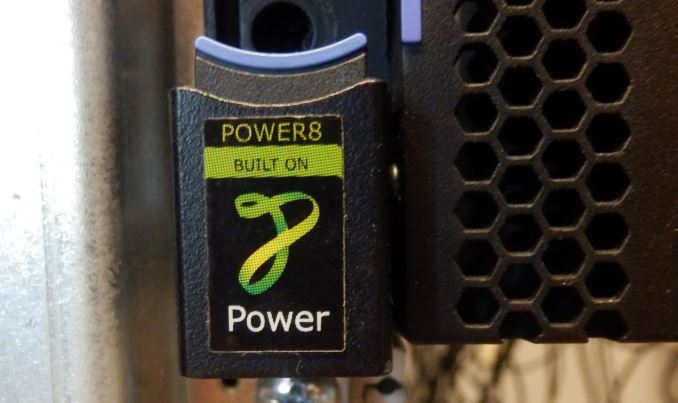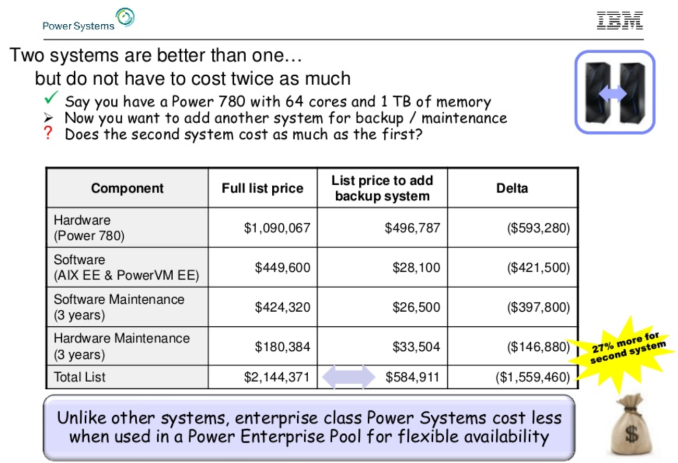The IBM POWER8 Review: Challenging the Intel Xeon
by Johan De Gelas on November 6, 2015 8:00 AM EST- Posted in
- IT Computing
- CPUs
- Enterprise
- Enterprise CPUs
- IBM
- POWER
- POWER8

Five years. That is how much time has passed since we have seen an affordable server processor that could keep up with or even beat Intel's best Xeons. These days no less than 95% of the server CPUs shipped are Intel Xeons. A few years ago, it looked like ARM servers were going to shake up the market this year, but to cut a long story short, it looks like the IBM POWER8 chip is probably the only viable alternative for the time being.
That was also noticeable in our Xeon E7 review, which was much more popular than we ever hoped. One of the reasons was the inclusion of a few IBM POWER8 benchmarks. We admit that the article was however incomplete: the POWER8 development machine we tested was a virtual machine with only 1 core, 8 threads and 2 GB of RAM, which is not enough to do any thorough server testing.
After seeing the reader interest in POWER8 in that previous article, we decided to investigate the matter further. To that end we met with Franz Bourlet, an enthusiastic technical sales engineer at IBM and he made sure we got access to an IBM S822L server. Thanks to Franz and the good people of Arrow Enterprise Computing Solutions, Arrow was able to lend us an IBM S822L server for our testing.
A Real Alternative?
Some of you may argue that the POWER based servers have been around for years now. But the slide below illustrates what we typically associated IBM's POWER range with:
Proudly, the IBM sales team states that you can save 1.5 million dollars after you have paid them 2 million dollars for your high-end 780 system. There is definitely a market for such hugely expensive and robust server systems as high end RISC machines are good for about 50,000 clients. But frankly for most of us, those systems are nothing more than an expensive curiosity.
Availability can be handled by software and most of us are looking/forced to reduce our capital expenses rather than increase them. We want fast, "reliable enough" servers at low costs that are easy to service. And that is exactly the reason why the single and dual sockets Xeon servers have been so popular the past decade. Can an IBM POWER server be a real alternative to the typical Xeon E5 server? The short but vague answer: a lot has changed in the past years and months. So yes, maybe.











146 Comments
View All Comments
hissatsu - Friday, November 6, 2015 - link
You might want to look more closely. Thought it's a bit blurry, I'm almost certain that's the 80+ Platinum logo, which has no color.DanNeely - Friday, November 6, 2015 - link
That's possible; it looks like there's something at the bottom of the logo. Google image search shows 80+ platinum as a lighter silver/gray than 80+ silver; white is only the original standard.Shezal - Friday, November 6, 2015 - link
Just look up the part number. It's a Platinum :)The12pAc - Thursday, November 19, 2015 - link
I have a S814, it's Platinum.johnnycanadian - Friday, November 6, 2015 - link
Oh yum! THIS is what I still love about AT: non-mainstream previews / reviews. REALLY looking forward to more like this. I only wish SGI still built workstation-level machines. :-(mapesdhs - Tuesday, November 10, 2015 - link
Indeed, but it'd need a hefty change in direction at SGI to get back into workstations again, so very unlikely for the forseeable future. They certainly have the required base tech (NUMALink6, MPI offload, etc.), namely lots of sockets/cores/RAM coupled with GPUs for really heavy tasks (big data, GIS, medical, etc.), ie. a theoretical scalable, shared-memory workstation. But the market isn't interested in advanced performance solutions like this atm, and the margin on standard 2/4-socket systems isn't worthwhile, it'd be much cheaper to buy a generic Dell or HP (plus, it's only above this no. of sockets that their own unique tech comes into play). Pity, as the equivalent of a UV 30/300 workstation would be sweet (if expensive), though for virtually all of the tasks discussed in this article, shared memory tech isn't relevant anyway. The notion of connectable, scalable, shared memory workstations based on NV gfx, PCIe and newer multi-core MIPS CPUs was apparently brought up at SGI way back before the Rackable merger, but didn't go anywhere (not viable given the financial situation at the time). It's a neat concept, eg. imagine being able to connect two or more separate ordinary 2/4-socket XEON workstations together (each fitted with, say, a couple of M6000s) to form a single combined system with one OS instance and resources pool, allowing users to combine & split setups as required to match workloads, but it's a notion whose time has not yet come.
Of course, what's missing entirely is the notion of advanced but costly custom gfx, but again there's no market for that atm either, at least not publicly. Maybe behind the scenes NV makes custom stuff the way SGI used to for relevant customers (DoD, Lockheed, etc.), but SGI's products always had some kind of commercially available equivalent from which the custom builds were derived (IRx gfx), whereas atm there's no such thing as a Quadro with 30000 cores and 100GB RAM that costs $50K and slides into more than one PCIe slot which anyone can buy if they have the moolah. :D
Most of all though, even if the demand existed and the tech could be built, it'd never work unless SGI stopped using its pricing-is-secret reseller sales model. They should have adopted a direct sales setup long ago, order on the site, pricing configurator, etc., but that never happened, even though the lack of such an option killed a lot of sales. Less of an issue with the sort of products they sell atm, but a better sales model would be essential if they were to ever try to sell workstations again, and that'd need a huge PR/sales management clearout to be viable.
Pity IBM couldn't pay NV to make custom gfx, that'd be interesting, but then IBM quit the workstation market aswell.
Ian.
mostlyharmless - Friday, November 6, 2015 - link
"There is definitely a market for such hugely expensive and robust server systems as high end RISC machines are good for about 50.000 servers. "Rounding error?
DanNeely - Friday, November 6, 2015 - link
50k clients would be my guess.FunBunny2 - Friday, November 6, 2015 - link
(dot) versus (comma) most likely. Euro centric versus 'Murcan centric.DanNeely - Friday, November 6, 2015 - link
If that was the case, a plain 50 would be much more appropriate.